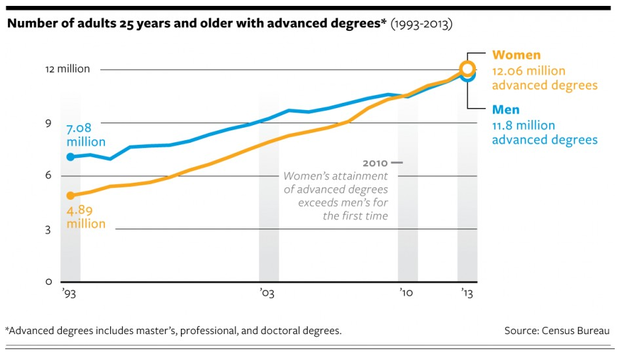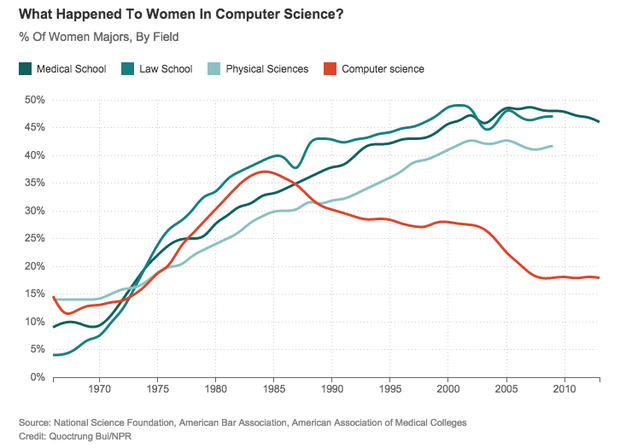The top tech priority of 2015: Two X chromosomes

Reshma Saujani (center) is the founder of Girls Who Code, one of the organizations inspiring young girls to embrace STEM topics.
Image: Girls Who Code
I work at the intersection of two industries -- technology and media -- that have some of the lowest representations of women. And, full disclosure, I'm a forty year old white dude.
That means I'm not very qualified to speak about gender bias, or the challenges of women in the workplace, or the benefits of social justice in society and business.
But, I'm going to talk about it anyway.
I'm going to talk about because it's the issue -- more than any other -- that can propel the tech industry forward in 2015, and I'll explain why.
I'm going to talk about it because science and technology pride themselves on letting the best ideas thrive, no matter where or who they come from, and we're not living up to that ideal.
I'm going to talk about it because the startup myth in the tech industry is built around the idea that it's all about whether you can execute an idea, and not enough women get the opportunity to do it.
I'm going to talk about it because nearly all of the most important mentors in my professional and personal life have been women, so I see the opportunity we're missing.
In all of these ways, we are cheating society of too many great ideas and too many great leaders, and we are robbing too many people of the opportunities they deserve to use their skills and talents to make a contribution to society. And that should be unacceptable to all us.
The problem in numbers
I could completely bombard you with depressing statistics about women in the tech industry, because I pulled a ton of data in researching this article. We could talk about how much less women earn than men, even when they are doing the exact same tech jobs. We could talk about the dearth of women in leadership and management positions in IT. We could talk about a lot of the other symptoms of inequality that continue to plague the tech industry, and the numbers that illustrate them.
But I don't want to overwhelm or cloud the issue. I also know some of you will whine about any of the numbers we put forward because you do it every time we write about women in IT on TechRepublic.
So instead, I'm going to give you two sets of straightforward data points that put the problem in perspective.
1. Women now earn more degrees and make up the majority of professional workers
Women now hold 57% of professional jobs in the US workforce, according to the US Department of Labor. Women now earn 57% of undergraduate degrees, according to the US Department of Education. Women also earn 60% of master's degrees and 51% of PhDs.
In 2010, the total number of women in the workforce with advanced degrees (masters, doctorate, or professional) passed men for the first time and has continued to climb, as seen in the chart below.

Data from US Census Bureau, chart by NationalJournal
2. Women in tech are declining in the US
Meanwhile, the representation of women in the technology industry has continued to decline. In the 1980's, 35% of computer science degrees were earned by women. That's now dropped to 20%. And, that happened during the same period that women zoomed ahead overall in earning degrees. It should also be noted that at the same time women were declining in computer science, they were rising in medicine and other scientific fields, as illustrated in the chart below.

Chart: NPR
According to the US Census Bureau, women held 27% of STEM jobs in the United States in 2011. That was down from a peak of 34% in 1990. Other numbers are even worse. Women hold only 13% of engineering jobs at tech companies and just 5% of tech startups are owned by women. Only about 8% of CIOs are women, down from 12% in 2010.
So, the bottom line is that women make up a larger and larger percentage of the pool of educated professionals in the United States, but fewer and fewer of them are choosing to work in the technology industry, which is arguably the most important growth engine for the economy and the most important source of innovation across almost every industry.
Why we need to do something about it
Meanwhile, 40% of the engineers in China are now women. Japan is not far behind, and women in India are flocking to STEM jobs in larger numbers.
The US is already lagging behind these countries in preparing the coming generations for the STEM jobs of the future -- 31 percent of US bachelor's degrees are awarded in STEM fields, versus 61 percent in Japan and 51 percent in China (and that's 2008 data, the numbers are likely even more stark now).
And as bad as it is the US is, the situation may be even worse for our friends in the UK, Canada, and Australia. A 2009 study from Frontiers: A Journal of Women's Studies found 19.3 percent of completed engineering degrees were awarded to women in the US, compared to 18.5 percent in Canada, 14.1 percent in Australia, and 9.5 percent in the UK. Again, the data is a little dated but the issue is clear.
If we write off so many women and don't give them equal opportunities to participate in the innovation jobs of the future, then we have no chance of keeping up.
Priorities
Lots of theories have been put forward to explain the decline of women in tech in the US in recent decades. The most recent guinea pig is the "brogrammer" culture that has coalesced in many technology teams. It's a real thing and it has to change in order to stop the women who are already in the tech industry from leaving to do something else. But, the problem also starts a lot sooner.
Research done by the Girls Scouts shows that 74% of grade school girls in the US are interested in STEM subjects, but they lose interest in middle school and then only 13% of them list STEM careers as their first choice.
NPR's Planet Money did a report in October 2014 called "When Women Stopped Coding" that pointed to a problem in the way technology has been marketed as a key factor contributing the decline of women in tech since the 1980s.
There are certainly other factors as well and they need to be studied and understood.
And, there are also good things happening, and they need to be amplified.
A whole movement of organizations like Girls Who Code have arisen in recent years to encourage and catalyze girls who want to learn about engineering and computer science. A new movement around toys and kits that teach engineering concepts to kids and appeal to both boys and girls -- such as GoldieBlox, littleBits, Kodable, and Kano -- is another positive step.
Women are also starting businesses at 1.5 times the national average in the US. So, at least some of them are going outside of the traditional career path and forging their own way. And while women-owned businesses only make up 4 percent of venture-backed tech companies, those women-led companies are achieving a 35 percent higher-than-normal return on investment and bringing in 12 percent higher revenue than average. Those kinds of numbers should naturally draw more investments toward female entrepreneurs in the future.
Leaders know that achieving goals and making progress is all about setting priorities. It's time for the technology industry to make equal opportunities for women a top priority. It's paramount to achieving our full potential as a society. And if the tech industry wants to continue to define itself as a meritocracy for the world's best ideas, then the entire industry needs to rally around finding the right solution to this problem.
I don't have the solution. In fact, I'm sure there isn't just one solution. But there are a lot of smart people in the tech industry. If we can start by uniting around the idea of being part of the solution and not part of the problem, then we can start a dialogue to make a difference. We can make this an everyone issue and not just a women's issue.

